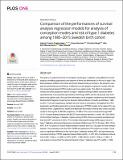Comparison of the performances of survival analysis regression models for analysis of conception modes and risk of type-1 diabetes among 1985–2015 Swedish birth cohort
Abstract
The goal is to examine the risk of conception mode-type-1 diabetes using different survival analysis modelling approaches and examine if there are differentials in the risk of type-1 diabetes between children from fresh and frozen-thawed embryo transfers. We aimed to compare the performances and fitness of different survival analysis regression models with the Cox proportional hazard (CPH) model used in an earlier study. The effect of conception modes and other prognostic factors on type-1 diabetes among children conceived either spontaneously or by assisted reproductive technology (ART) and its sub-groups was modelled in the earlier study. We used the information on all singleton children from the Swedish Medical Birth Register hosted by the Swedish National Board of Health and Welfare, 1985 to 2015. The main explanatory variable was the mode of conception. We applied the CPH, parametric and flexible parametric survival regression (FPSR) models to the data at 5% significance level. Loglikelihood, Akaike and Bayesian information criteria were used to assess model fit. Among the 3,138,540 singletons, 47,938 (1.5%) were conceived through ART (11,211 frozen-thawed transfer and 36,727 fresh embryo transfer). In total, 18,118 (0.58%) of the children had type-1 diabetes, higher among (0.58%) those conceived spontaneously than the ART-conceived (0.42%). The median (Interquartile range (IQR)) age at onset of type-1 diabetes among spontaneously conceived children was 10 (14–6) years, 8(5–12) for ART, 6 (4–10) years for frozen-thawed embryo transfer and 9 (5–12) years for fresh embryo transfer. The estimates from the CPH, FPSR and parametric PH models are similar. There was no significant difference in the risk of type-1 diabetes among ART- and spontaneously conceived children; FPSR: (adjusted Hazard Ratio (aHR) = 1.070; 95% Confidence Interval (CI):0.929–1.232, p = 0.346) vs CPH: (aHR = 1.068; 95%CI: 0.927–1.230, p = 0.361). A sub-analysis showed that the adjusted hazard of type-1 diabetes was 37% (aHR = 1.368; 95%CI: 1.013–1.847, p = 0.041) higher among children from frozen-thawed embryo transfer than among children from spontaneous conception. The hazard of type-1 diabetes was higher among children whose mothers do not smoke (aHR = 1.296; 95%CI:1.240–1.354, p<0.001) and of diabetic mothers (aHR = 6.419; 95%CI:5.852–7.041, p<0.001) and fathers (aHR = 8.808; 95%CI:8.221–9.437, p<0.001). The estimates from the CPH, parametric models and the FPSR model were close. This is an indication that the models performed similarly and any of them can be used to model the data. We couldn’t establish that ART increases the risk of type-1 diabetes except when it is subdivided into its two subtypes. There is evidence of a greater risk of type-1 diabetes when conception is through frozen-thawed transfer.
Citation
Fagbamigbe , A F , Norrman , E , Bergh , C , Wennerholm , U-B & Petzold , M 2021 , ' Comparison of the performances of survival analysis regression models for analysis of conception modes and risk of type-1 diabetes among 1985–2015 Swedish birth cohort ' , PLoS ONE , vol. 16 , no. 6 , e0253389 . https://doi.org/10.1371/journal.pone.0253389
Publication
PLoS ONE
Status
Peer reviewed
ISSN
1932-6203Type
Journal article
Collections
Items in the St Andrews Research Repository are protected by copyright, with all rights reserved, unless otherwise indicated.

